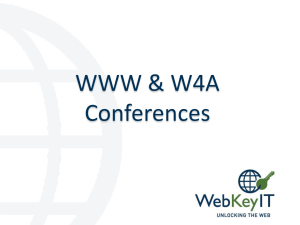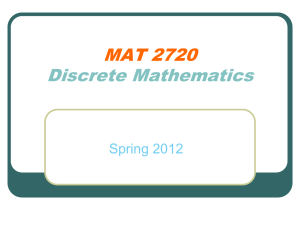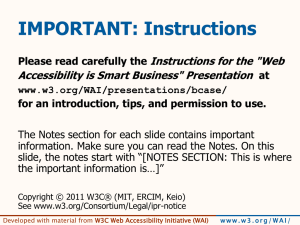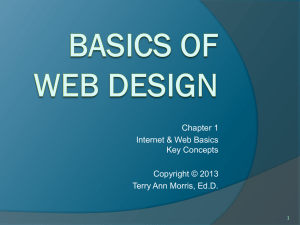Presentation format - World Wide Web Consortium
advertisement
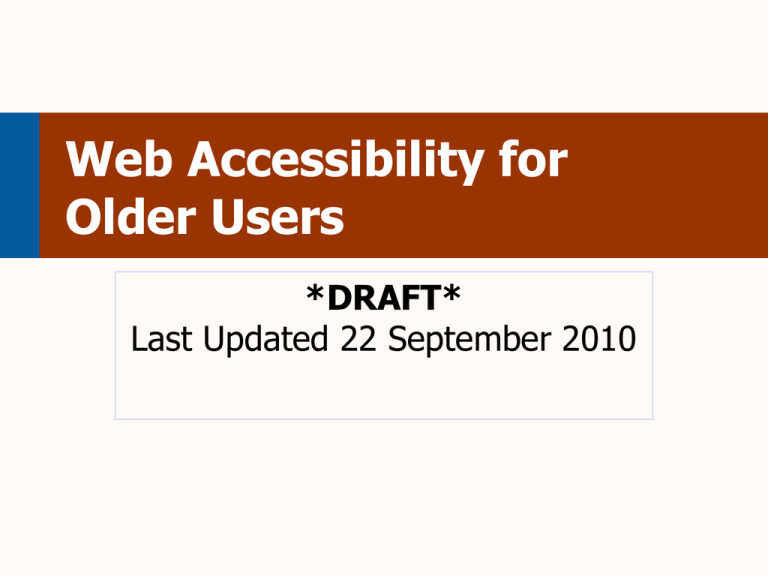
Web Accessibility for Older Users *DRAFT* Last Updated 22 September 2010 Presentation overview Introducing WAI-AGE Demographic changes Changing abilities Use of the Web Understanding older people's needs Role of WAI guidelines Project outcomes Developed with material from W3C Web Accessibility Initiative (WAI) www.w3.org/WAI/ Introducing WAI-AGE WAI-AGE Project (IST 355015) (WAI Ageing, Education and Harmonisation) European Commission funded project focused on: • Better understanding the needs of older web users • Participation of older users in W3C standardization • Development of educational materials • Pursuit of standards harmonization www.w3.org/WAI/WAI-AGE/ Developed with material from W3C Web Accessibility Initiative (WAI) www.w3.org/WAI/ World Wide Web Consortium (W3C) Leading the Web to Its Full Potential: • International vendor-neutral consortium • Evolution and interoperability of the Web for everyone, everywhere on everything • Operates from: MIT, ERCIM, and Keio • Multi-stakeholder, consensus process • Open and royalty-free Web standards: • HTML, CSS, XML, SVG, SMIL, ... www.w3.org Developed with material from W3C Web Accessibility Initiative (WAI) www.w3.org/WAI/ Web Accessibility Initiative (WAI) Works to help make the Web accessible to people with disabilities through: • Accessibility support in W3C technologies • Guidelines for implementing accessibility • Methods for evaluating accessibility • Conducting education and outreach • Coordinating with R&D world-wide www.w3.org/WAI/ Developed with material from W3C Web Accessibility Initiative (WAI) www.w3.org/WAI/ Changing demographics Global demographic changes United Nations global demographic forecast 65+ years 80+ years 2010 7.6% 1.5% 2020 9.3% 1.9% 2030 11.7% 2.3% 2040 2050 14.2% 16.2% 3.3% 4.3% 20 Percent Year 10 0 2010 2020 2030 2040 2050 Year 80+ years 65+ years Source: UN World Population Prospects Developed with material from W3C Web Accessibility Initiative (WAI) www.w3.org/WAI/ European situation Demographic forecast for the EU 65+ years 80+ years 2010 17% 5% 2020 20% 6% 2030 24% 7% 2040 2050 27% 29% 8% 12% 30 Percent Year 20 10 0 2010 2020 2030 2040 2050 Year 65+ years 80+ years Source: EuroStat Developed with material from W3C Web Accessibility Initiative (WAI) www.w3.org/WAI/ Changing abilities Ageing and hearing loss Impact: Prevalence: • Audio can be difficult to discern • 47% of people 61 to 80 years • Higher pitch sounds can be missed • 93% of people 81+ years Developed with material from W3C Web Accessibility Initiative (WAI) www.w3.org/WAI/ Ageing and vision decline Impact: • Decreasing ability to focus on near tasks • Changing color perception and sensitivity • Decreasing contrast sensitivity Prevalence: (significant vision loss) • 16% of people 65 - 74 years • 19% of people 75 – 84 years • 46% of people 85+ years Developed with material from W3C Web Accessibility Initiative (WAI) www.w3.org/WAI/ Ageing and physical decline Impact: (Motor skill decline can result from many conditions including arthritis and Parkinson's Disease) • Difficulty using mouse or keyboard Prevalence: (Conditions most commonly reported) • Arthritis • At least 50% of people over 65 affected • Difficult to click small areas • Essential tremor • Strain from nonergonomic tasks • Parkinson's Disease • Affects up to 20% of people over 65 • Approximately 4% of people over 85 affected Developed with material from W3C Web Accessibility Initiative (WAI) www.w3.org/WAI/ Ageing and cognitive decline Impact: Navigation, comprehension, and task completion can be affected by: • Short term memory problems • Difficulty with concentration • Distraction from movement or irrelevant material • Difficulty coping with information overload Prevalence: (Conditions most commonly reported) • Dementia: • 1.4% of people 65-69 yrs • 24% of people 85+ yrs • Mild cognitive impairment (MCI) is more common: • Around 20% of people over 70 years are estimated to experience MCI Developed with material from W3C Web Accessibility Initiative (WAI) www.w3.org/WAI/ Use of the Web Older people online The Web provides older people with unprecedented opportunities for: • social interaction and communication • access to information • access to eCommerce • access to government services and civic participation • training and learning opportunities • employment, research, and access to workplace applications Developed with material from W3C Web Accessibility Initiative (WAI) www.w3.org/WAI/ Barriers to web use Older people are experiencing web accessibility barriers due to: • poor design and poor coding of websites • complex software and assistive technologies • little or no prior experience with computers Web accessibility is an imperative. Developed with material from W3C Web Accessibility Initiative (WAI) www.w3.org/WAI/ Accessibility for older web users Understanding older peoples' needs WAI-AGE literature review included material about: Impairments associated with ageing Web site design requirements for older people Implications of particular impairments on Web use Older users' interaction with particular aspects of Web sites See "Web Accessibility for Older Users: A Literature Review" for details Developed with material from W3C Web Accessibility Initiative (WAI) www.w3.org/WAI/ Observations from the literature review WAI-AGE analysis showed a significant overlap with W3C/WAI recommendations. It was also observed that: • Many studies seemed unaware of the W3C/WAI work • Studies often seemed not to build on previous work • Web inexperience is an influencing factor • Information overload was commonly identified • Less technical, more usability, requirements predominated • Usability features of forms were highlighted Developed with material from W3C Web Accessibility Initiative (WAI) www.w3.org/WAI/ Observations from the literature review - continued Additional observations include: • The accessibility requirements of older users did not seem well understood by industry • Accessibility options were not appreciated by users • Adaptive strategies were seldom considered • Assistive technology was not discussed • Some recommendations reflected a lack of technical knowledge • Hearing as an impairment was ignored Developed with material from W3C Web Accessibility Initiative (WAI) www.w3.org/WAI/ Role of WAI Guidelines W3C/WAI guidelines W3C/WAI guidelines help older Web users Web Content Accessibility Guidelines (WCAG) User Agent Accessibility Guidelines (UAAG) Authoring Tool Accessibility Guidelines (ATAG) See Essential Components of Web Accessibility Developed with material from W3C Web Accessibility Initiative (WAI) www.w3.org/WAI/ Accessible Web content Requirements include: • Readable and understandable text • Identifiable and understandable links • Clear and identifiable headings • Good orientation and navigation WAI's Web Content Accessibility Guidelines (WCAG) 2.0 addresses these Developed with material from W3C Web Accessibility Initiative (WAI) www.w3.org/WAI/ Usability improvements Usability improvements especially help older people and people with disabilities: • Page layout and design - provide consistency and avoid overload • Text presentation - use left justification, increase line spacing & margins, avoid italics and underlining • Forms - avoid complexity and provide clear guidance • Menus and links - provide predictability and consistency Developed with material from W3C Web Accessibility Initiative (WAI) www.w3.org/WAI/ Role of Web browsers Browsers are the entry-point to the Web: • many older users are overwhelmed by the functionality • accessibility features are often not easy to configure • some browsers do not work with assistive technology • people who are new to the Web are especially affected Developed with material from W3C Web Accessibility Initiative (WAI) www.w3.org/WAI/ Web authoring Older people contribute to the Web: • using content management systems such as on a corporate intranet • using social media applications such as wikis, blogs, and forums • developing Web sites professionally or for leisure WAI's Authoring Tool Guidelines (ATAG) help address these issues. Developed with material from W3C Web Accessibility Initiative (WAI) www.w3.org/WAI/ Project outcomes Ongoing WAI-AGE work Raising awareness of Web accessibility for older people Better explaining the applicability of the WAI guidelines for older people Avoiding potential fragmentation through reinvention of requirements Encouraging participation of older people in W3C/WAI standardization Developed with material from W3C Web Accessibility Initiative (WAI) www.w3.org/WAI/ Educational resources - industry WAI-AGE is developing resources to inform developers and help them: • Understand the benefits of developing accessible sites for older users • Understand the accessibility requirements of older people • Understand how the WAI guidelines apply to the needs of older users • Include older people throughout the design and development process Developed with material from W3C Web Accessibility Initiative (WAI) www.w3.org/WAI/ Educational resources - users WAI-AGE is developing resources for older users and their supporting organizations: • Increase users' awareness of the benefits of Web accessibility • Guidance on using accessibility features • Identifying and reporting Web accessibility problems • Providing information on the findings of the WAIAGE Project Developed with material from W3C Web Accessibility Initiative (WAI) www.w3.org/WAI/ Summary of WAI-AGE resources WAI-AGE is revising existing WAI resources, including: • Developing a Web Accessibility Business Case for Your Organization • Before and After Demonstration (BAD) website • Involving Users in Web Projects for Better, Easier Accessibility • Developing Web Accessibility Presentations and Training WAI-AGE is developing new WAI resources, including: • Better Web Browsing - Tips to customize your computer (draft) • Contacting Organizations about Inaccessible Websites • Developing Websites for Older People • The Relationship between Web Accessibility and Usability Developed with material from W3C Web Accessibility Initiative (WAI) www.w3.org/WAI/ Standards harmonisation Working together to avoid fragmentation through: • Ongoing dialogue with different standards organizations • Ongoing dialogue with user organizations • Promoting a better understanding of Web accessibility • Promoting an understanding of the needs of all users • Encouraging the participation of all users in standardization Developed with material from W3C Web Accessibility Initiative (WAI) www.w3.org/WAI/ Research opportunities Some gaps that need investigation: • Impact of hearing loss on multimedia use • Cognitive decline and page comprehension • Use of social networking sites and applications • Use of assistive technologies by older people Developed with material from W3C Web Accessibility Initiative (WAI) www.w3.org/WAI/ Become involved People are invited to participate by: • Following the project updates on www.w3.org/WAI/WAI-AGE • Participating actively or monitoring the WAI-AGE mailing list • Commenting on the WAI-AGE deliverables as they develop • Participating in WAI Working Groups • Contributing relevant research findings Developed with material from W3C Web Accessibility Initiative (WAI) www.w3.org/WAI/ Thank you WAI home page: • www.w3.org/WAI/ WAI-AGE project page: • www.w3.org/WAI/WAI-AGE/ Additional reference material available: • www.w3.org/WAI/presentations/ageing/ The WAI-AGE Project is supported by: Developed with material from W3C Web Accessibility Initiative (WAI) www.w3.org/WAI/
